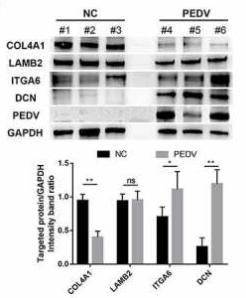DCN Antibody - #DF6543
| Product: | DCN Antibody |
| Catalog: | DF6543 |
| Description: | Rabbit polyclonal antibody to DCN |
| Application: | WB IHC IF/ICC |
| Cited expt.: | WB |
| Reactivity: | Human, Mouse, Rat |
| Prediction: | Pig, Bovine, Sheep |
| Mol.Wt.: | 30kDa; 40kD(Calculated). |
| Uniprot: | P07585 |
| RRID: | AB_2838505 |
Related Downloads
Protocols
Product Info
*The optimal dilutions should be determined by the end user. For optimal experimental results, antibody reuse is not recommended.
*Tips:
WB: For western blot detection of denatured protein samples. IHC: For immunohistochemical detection of paraffin sections (IHC-p) or frozen sections (IHC-f) of tissue samples. IF/ICC: For immunofluorescence detection of cell samples. ELISA(peptide): For ELISA detection of antigenic peptide.
Cite Format: Affinity Biosciences Cat# DF6543, RRID:AB_2838505.
Fold/Unfold
Bone proteoglycan II; CSCD; DCN; DCN protein; Decorin; Decorin proteoglycan; Dermatan sulphate proteoglycans II; DKFZp686J19238; DSPG 2; DSPG2; PG 40; PG II; PG S2; PG-S2; PG40; PGII; PGS 2; PGS2; PGS2_HUMAN; Proteoglycan core protein; SLRR1B; Small leucine rich protein 1B;
Immunogens
A synthesized peptide derived from human DCN, corresponding to a region within the internal amino acids.
- P07585 PGS2_HUMAN:
- Protein BLAST With
- NCBI/
- ExPASy/
- Uniprot
MKATIILLLLAQVSWAGPFQQRGLFDFMLEDEASGIGPEVPDDRDFEPSLGPVCPFRCQCHLRVVQCSDLGLDKVPKDLPPDTTLLDLQNNKITEIKDGDFKNLKNLHALILVNNKISKVSPGAFTPLVKLERLYLSKNQLKELPEKMPKTLQELRAHENEITKVRKVTFNGLNQMIVIELGTNPLKSSGIENGAFQGMKKLSYIRIADTNITSIPQGLPPSLTELHLDGNKISRVDAASLKGLNNLAKLGLSFNSISAVDNGSLANTPHLRELHLDNNKLTRVPGGLAEHKYIQVVYLHNNNISVVGSSDFCPPGHNTKKASYSGVSLFSNPVQYWEIQPSTFRCVYVRSAIQLGNYK
Predictions
Score>80(red) has high confidence and is suggested to be used for WB detection. *The prediction model is mainly based on the alignment of immunogen sequences, the results are for reference only, not as the basis of quality assurance.
High(score>80) Medium(80>score>50) Low(score<50) No confidence
Research Backgrounds
May affect the rate of fibrils formation.
The attached glycosaminoglycan chain can be either chondroitin sulfate or dermatan sulfate depending upon the tissue of origin.
Secreted>Extracellular space>Extracellular matrix.
Belongs to the small leucine-rich proteoglycan (SLRP) family. SLRP class I subfamily.
Research Fields
· Environmental Information Processing > Signal transduction > TGF-beta signaling pathway. (View pathway)
· Human Diseases > Cancers: Overview > Proteoglycans in cancer.
References
Application: WB Species: Mouse Sample:
Application: WB Species: Pig Sample: Porcine intestinal epithelial cells
Restrictive clause
Affinity Biosciences tests all products strictly. Citations are provided as a resource for additional applications that have not been validated by Affinity Biosciences. Please choose the appropriate format for each application and consult Materials and Methods sections for additional details about the use of any product in these publications.
For Research Use Only.
Not for use in diagnostic or therapeutic procedures. Not for resale. Not for distribution without written consent. Affinity Biosciences will not be held responsible for patent infringement or other violations that may occur with the use of our products. Affinity Biosciences, Affinity Biosciences Logo and all other trademarks are the property of Affinity Biosciences LTD.





